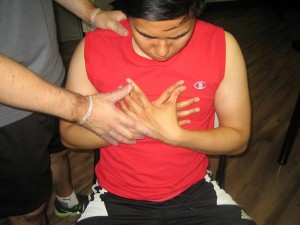Hyperventilation occurs when an individual overly breathes – exhaling and inhaling very rapid and shallow. Usually, an individual who rapidly breathes causes panic attacks or anxiety but there are some serious medical conditions that can result to hyperventilation.
Symptoms of hyperventilation
- At first, confusion, dizziness and lightheadedness
- Fast or increased rate of breathing
- Weakness, numbness or tingling sensations in the arms or mouth
- Muscle spasms in the hands and feet
- Lastly, chest pain and palpitation
Causes

- Hyperventilation can be caused by over-breathing
- Some medical conditions such as loss of blood, infections, heart and lung disorders.
Treatment
- Breathe into a paper bag to reuse carbon dioxide that is lost during exhalation, maintain proper levels in the body and prevent the symptoms of hyperventilation. Generally, avoid using plastic bags to prevent choking. Be sure the paper bag is clean with no small items inside that can be accidentally inhaled.
- Cover the mouth and the nose completely with the paper bag to make sure that the carbon dioxide is inside the paper bag. Pinch the bag slightly to fit over the mouth and nose easily and place the opening of the bag directly and completely over the mouth and nose.
- Once the paper bag is over the mouth and nose, start breathing in and out of the bag. Remain calm and just breathe naturally during an episode of hyperventilation. Furthermore, take at least 6-12 slow breaths using the paper bag. Remove the paper bag from the mouth and nose and breathe without the paper bag.
- Perform some breathing techniques such as breathing through pursed lips which is the simplest way on controlling shortness of breath and gives an easy way to slow down the pace of breathing. Generally, it is a technique of exhaling on tightly pressed lips and inhaling with the nose and mouth closed. This technique improves ventilation, breathing patterns by moving old air out of the lungs and breathing in new air into the lungs and for general relaxation of the body. In addition, use this technique when performing activities such as bending, climbing stairs and lifting at least 4-5 times every day to establish a proper breathing pattern.
Tips
- Breathe through the nose to prevent hyperventilation
- Loosen clothing, tight belts, girdles, bras and skin tight jeans to prevent restricted breathing that can result to shallow chest breathing.
- Eat a healthy variety of foods such as fresh fruits and vegetables. Minimize drinking coffee, tea and soda.
- Perform regular aerobic exercises that requires taking in full breathes and lessens anxiety that results to hyperventilation.
- Encourage the individual to get plenty of sleep to prevent daytime anxiety.
- Practice healthy thinking and avoid negative thoughts.
Disclaimer
The material posted on this page for hyperventilation is for learning purposes only. If you have severe episode of hyperventilation consult your local physician. If you want to learn to properly manage hyperventilation register for a first aid course with a training provider near you.
FACT CHECK
https://www.healthline.com/symptom/hyperventilation
https://www.webmd.com/lung/lung-hyperventilation-what-to-do#1
